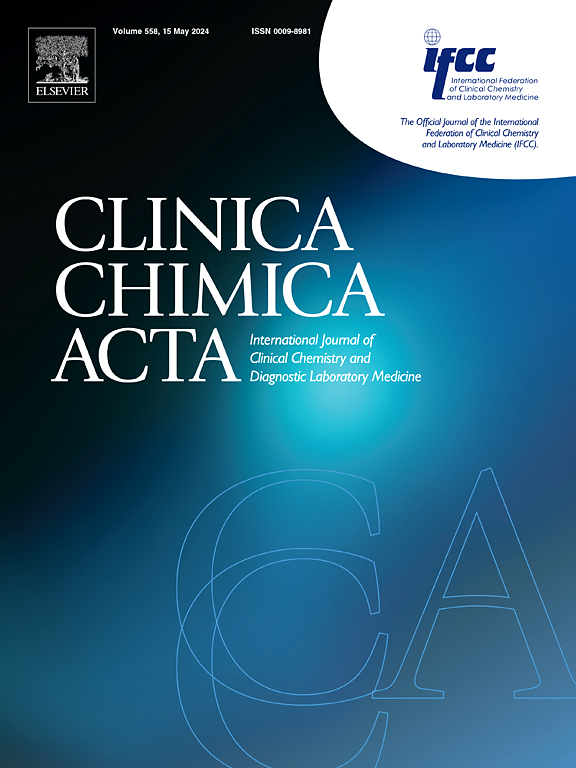Daily dosing frequency as a determinant of clozapine concentration-to-dose ratio: Data from a therapeutic drug monitoring service (2019–2022)
IF 3.2
3区 医学
Q2 MEDICAL LABORATORY TECHNOLOGY
引用次数: 0
Abstract
Background and Aims
Daily dosing frequency is an important factor influencing the plasma concentration of clozapine. This study investigated pharmacokinetic parameters in different daily dosing frequency regimens of clozapine in a naturalistic therapeutic drug monitoring sample to establish the necessary clozapine dosage to achieve plasma levels of 350–600 ng/mL in the Chinese population.
Study design
A single-center, retrospective, cross-sectional study was conducted at Xi’an Mental Health Center in China, where data on clozapine-treated patients between 2019 and 2022 were collected. The clozapine concentration-to-dose (C/D) ratios were compared between subgroups receiving different dosing regimens (once, twice, or three times per day) using Kruskal–Wallis H and Mann–Whitney U-tests.
Study Results
The Kruskal–Wallis H test indicated significant variations in the C/D ratios among the three groups (p < 0.001). These findings were also consistent with the sex and age subgroup analyses. The receiver operating characteristic (ROC) analysis revealed that the twice-daily group required a daily clozapine dose of 125–225 mg to achieve the expected therapeutic reference concentration, with a corresponding clozapine C/D ratio of 1.6–2.8. The daily dose needed to reach therapeutic clozapine levels was higher in men than in women and in patients aged ≤ 44 years than in those aged ≥ 45 years.
Conclusions
The daily clozapine dosing frequency is an important factor influencing the pharmacokinetic profile of clozapine. Large-scale, multicenter, prospective studies are needed to validate the clinically significant results of this study by administering the same total daily dose at different daily dosing frequencies.
每日给药频率作为氯氮平浓度剂量比的决定因素:来自治疗药物监测服务的数据(2019-2022)
背景与目的每日给药频率是影响氯氮平血药浓度的重要因素。本研究在自然治疗药物监测样本中研究了氯氮平不同日给药频率方案的药代动力学参数,以确定中国人群达到350-600 ng/mL血浆水平所需的氯氮平剂量。研究设计在中国西安精神卫生中心进行了一项单中心、回顾性、横断面研究,收集了2019年至2022年氯氮平治疗患者的数据。采用Kruskal-Wallis H检验和Mann-Whitney u检验比较接受不同给药方案(每天1次、2次或3次)的亚组间氯氮平浓度剂量比(C/D)。研究结果Kruskal-Wallis H检验显示,三组患者的C/D比值存在显著差异(p <;0.001)。这些发现也与性别和年龄亚组分析一致。受试者工作特征(ROC)分析显示,每日两次组需要每日125-225 mg氯氮平剂量才能达到预期的治疗参考浓度,相应的氯氮平C/D比为1.6-2.8。达到治疗性氯氮平水平所需的日剂量男性高于女性,年龄≤44岁的患者高于年龄≥45岁的患者。结论氯氮平日给药频率是影响氯氮平药动学特征的重要因素。需要大规模、多中心、前瞻性的研究来验证本研究的临床意义,在不同的日给药频率下给予相同的总日剂量。
本文章由计算机程序翻译,如有差异,请以英文原文为准。
求助全文
约1分钟内获得全文
求助全文
来源期刊

Clinica Chimica Acta
医学-医学实验技术
CiteScore
10.10
自引率
2.00%
发文量
1268
审稿时长
23 days
期刊介绍:
The Official Journal of the International Federation of Clinical Chemistry and Laboratory Medicine (IFCC)
Clinica Chimica Acta is a high-quality journal which publishes original Research Communications in the field of clinical chemistry and laboratory medicine, defined as the diagnostic application of chemistry, biochemistry, immunochemistry, biochemical aspects of hematology, toxicology, and molecular biology to the study of human disease in body fluids and cells.
The objective of the journal is to publish novel information leading to a better understanding of biological mechanisms of human diseases, their prevention, diagnosis, and patient management. Reports of an applied clinical character are also welcome. Papers concerned with normal metabolic processes or with constituents of normal cells or body fluids, such as reports of experimental or clinical studies in animals, are only considered when they are clearly and directly relevant to human disease. Evaluation of commercial products have a low priority for publication, unless they are novel or represent a technological breakthrough. Studies dealing with effects of drugs and natural products and studies dealing with the redox status in various diseases are not within the journal''s scope. Development and evaluation of novel analytical methodologies where applicable to diagnostic clinical chemistry and laboratory medicine, including point-of-care testing, and topics on laboratory management and informatics will also be considered. Studies focused on emerging diagnostic technologies and (big) data analysis procedures including digitalization, mobile Health, and artificial Intelligence applied to Laboratory Medicine are also of interest.
 求助内容:
求助内容: 应助结果提醒方式:
应助结果提醒方式:


